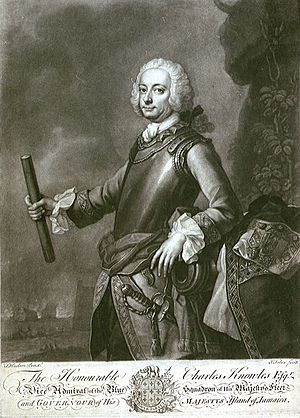Battle of Puerto Cabello facts for kids
Quick facts for kids Battle of Puerto Cabello |
|||||||
|---|---|---|---|---|---|---|---|
| Part of the War of Jenkins' Ear | |||||||
|
|||||||
| Belligerents | |||||||
| Commanders and leaders | |||||||
| Charles Knowles | Gabriel Zuloaga | ||||||
| Strength | |||||||
| Land: 4,000 infantry sailors Sea: 2 third-rates 2 fourth rates 1 fifth-rate 2 sixth-rates 1 sloop-of-war 1 bomb vessel 13 other vessels |
Land: 2,000 infantry militia unknown artillery 1 castle 2 shore batteries Sea: 1 blockship |
||||||
| Casualties and losses | |||||||
| 300 killed 106 wounded 700 captured 2 ships sunk |
Unknown human casualties 1 blockship scuttled |
||||||
The Battle of Puerto Cabello was a big fight at sea and on land. It happened on April 16, 1743. British forces tried to capture a Spanish port called Puerto Cabello. This port was in what is now Venezuela. The battle was part of a larger conflict known as the War of Jenkins' Ear. The British attack failed, and the Spanish won.
Contents
Why They Fought: The Background
Before attacking Puerto Cabello, British ships led by Commodore Sir Charles Knowles had tried to capture another Spanish port, La Guaira. That attack failed too, on March 2, 1743. La Guaira was a very important shipping center for the Royal Gipuzkoan Company. The British thought it would be easy to capture, but they were wrong.
After the failure at La Guaira, Commodore Knowles decided to attack Puerto Cabello. This port was also very important to the Royal Gipuzkoan Company. It was where their ships were repaired (a careening port). These ships helped the Spanish navy a lot during the war. They carried soldiers, weapons, and supplies from Spain to its colonies. Destroying Puerto Cabello would hurt both the company and the Spanish government.
The British fleet included several warships:
- HMS Suffolk (70 guns)
- HMS Burford (70 guns)
- HMS Norwich (50 guns)
- HMS Assistance (50 guns)
- HMS Eltham (40 guns)
- HMS Scarborough (24 guns)
- HMS Lively (20 guns)
- HMS Otter (14 guns, a small, fast ship called a sloop)
- HMS Comet (8 guns, a ship that fired bombs)
The Battle Begins!
Commodore Knowles and his fleet arrived near the Spanish port of Borburata. He first sent the bomb vessel HMS Comet closer to shore. The Spanish quickly spotted HMS Otter and raised the alarm.
The next day, three British warships – HMS Norwich, HMS Eltham, and HMS Lively – began firing at two small Spanish batteries. These batteries were like small forts with cannons. The British hoped to weaken the Spanish defenders. After this, a large group of British soldiers would land secretly at night. Their plan was to capture these small forts and then use the Spanish cannons against the main Spanish fort, San Felipe Castle.
First Attack and Failure
Knowles' plan started well. The three warships fired at the batteries until 7:00 P.M. Then, between 1,100 and 1,200 British soldiers landed without being seen. But as they moved forward, they ran into a small group of 40 Spanish soldiers. These Spanish soldiers had two small cannons that fired grape shot. Grape shot was like a giant shotgun blast, scattering many small metal balls. This small Spanish group managed to scare the British soldiers, who ran back to their boats.
On April 28, the three British warships tried bombarding the batteries again, but it didn't do much. On May 2, the Governor of Caracas, Gabriel de Zuloaga, arrived with more Spanish soldiers to help defend the port. The next day, Governor de Zuloaga was wounded in the leg by British fire while checking on one of the batteries.
Final Push and Retreat
By this time, the British were running low on ammunition and supplies. Knowles decided to try a big attack on May 4. However, the wind stopped, so they had to wait until May 5.
On May 5, Knowles' ships started moving at 11:00 A.M., and the Spanish got ready to defend. Several British ships, including HMS Assistance, HMS Burford, HMS Suffolk, and HMS Norwich, were supposed to attack San Felipe Castle. Other ships like HMS Scarborough, HMS Lively, and HMS Eltham were to fire at the northern batteries.
The battle began again shortly after 1:00 P.M. The British warships got very close to San Felipe Castle. At 4:00 P.M., the wind picked up. Governor de Zuloaga thought the British might try to rush into the harbor. So, he ordered a blockship to be scuttled (sunk on purpose) in the harbor entrance. When Knowles saw the channel closing, he signaled for his ships to retreat. However, his ships became stuck because the wind died down again. The British suffered many hits before finally getting out of range by 9:00 P.M.
What Happened Next?
The British had about 100 soldiers hurt during this last attack, plus another 100 from earlier attempts. On the morning of May 7, Knowles sent his most damaged ships to the Borburata Keys. He continued to shell Puerto Cabello's inner harbor with his bomb vessel.
Commodore Knowles eventually offered to exchange prisoners with Governor Zuloaga. After being allowed to get fresh water, Knowles sailed away with his ships in two groups on May 11 and May 13, heading for Jamaica. The Battle of Puerto Cabello was a clear Spanish victory.
See also
 In Spanish: Batalla de Puerto Cabello para niños
In Spanish: Batalla de Puerto Cabello para niños


